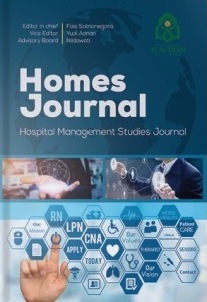COMMUNITY ACCESS TO HEALTH SERVICES DURING THE COVID-19 PANDEMIC
Abstract
During the current Covid-19 pandemic, public visits to health facilities such as hospitals, health centers and clinics have decreased. People are increasingly worried about visiting health facilities for fear of contracting it. The purpose of this study was to measure the level of public concern about visiting a health facility during a pandemic when experiencing health problems. This research is a quantitative research using an analytical approach and study designcross sectional. The population in this study were all Indonesian people and the number of samples in this study were 118 people. The analytical method used is univariate about the respondent's identity (gender, age, occupation, and education) and bivariate to determine the correlation of the independent variables with the dependent variable using the test chi square. The sampling technique uses the technique accidental sampling. The results of the study showed that there was no relationship between the level of knowledge and the level of public concern about visiting health facilities p-value 0.421.
References
Fathurrahman, M. I. (2022). Upaya Kota Kediri Menangani Kasus Covid-19.
Fitrianty, F., Retnaningsih, U. O., & Nizmi, Y. E. (2021). Peran World Health Organization (WHO) Dalam Menangani Covid-19 Di Indonesia (2019-2021). Nusantara: Jurnal Ilmu Pengetahuan Sosial, 8(7), 1889-1914.
Halim, M. H., & Marwanaya, R. (2021). Aplikasi Terpadu Dan Terintegrasi Untuk Diagnosis Awal Penanganan Suspek Covid-19 Untuk Masyarakaat Umum Dan Rumah Sakit Rujukan. Jurnal Tika, 6(03), 247-253.
Kasiram, M. (2008). Metodologi penelitian kuantitatif dan kualitatif. Malang: UIN-Malang
Notoatmodjo, S. (2010). Ilmu perilaku kesehatan. Jakarta: rineka cipta, 200, 26-35.
Purnamasari, I., & Raharyani, A. E. (2020). Tingkat pengetahuan dan perilaku masyarakat Kabupaten Wonosobo tentang Covid-19. Jurnal ilmiah kesehatan, 10(1), 33-42.
Purwanti, S. (2020). Dampak penurunan jumlah kunjungan kb terhadap ancaman baby boom di era Covid-19. Jurnal Bina Cipta Husada, 16(2), 105-118.
Puspitorini, F. (2020). Strategi Pembelajaran Di Perguruan Tinggi Pada Masa Pandemi Covid-19. Jurnal Kajian Ilmiah, 1(1).
Sari, D., & Windusari, Y. (2021). Tingkat Kepatuhan Personal Hygiene Dan Penerapan Protokol Kesehatan Pada Pedagang Makanan Di Bundaran Kota Sekayu Untuk Mencegah Penyebaran Covid-19 (Doctoral dissertation, Sriwijaya University).
Syahrial, S. (2020). Dampak COVID-19 terhadap tenaga kerja di Indonesia. Jurnal Ners, 4(2), 21-29.


